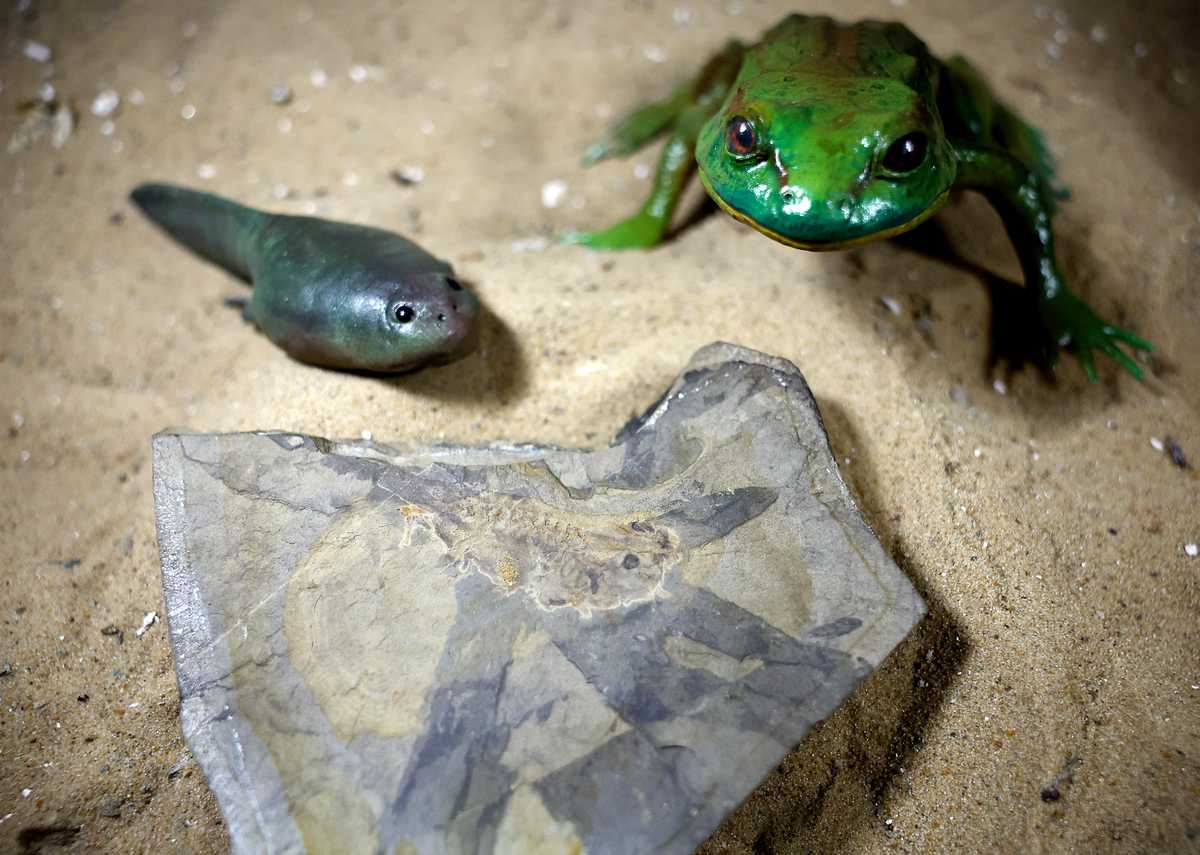
A fossil of the world’s oldest tadpole, which coexisted with dinosaurs in the Middle Jurassic about 165 million years ago, is seen next to a 3D-printed representation of the tadpole and of a fully developed frog, in Buenos Aires on Oct. 28.
17:36 JST, November 6, 2024
BUENOS AIRES (Reuters) — Scientists in Argentina have discovered excellently preserved fossil remains of the oldest-known tadpole, the larval stage of a large frog species that lived alongside dinosaurs about 161 million years ago during the Jurassic Period.
The researchers said the fossil, measuring 16 centimeters long, sheds light on the evolution of frogs and toads, showing that tadpoles today are largely unchanged from their forerunners in the Jurassic. The oldest-known frog fossils date to even earlier, though no older tadpole fossils have been found.
The specimen, belonging to a previously known species called Notobatrachus degiustoi, is so well preserved, according to the researchers, that it includes the remains of some soft tissues that usually are not seen in fossils. The tadpole’s eyes and nerves, for instance, are preserved as dark imprints in their anatomical position in the fossil.
The fossil was found in 2020 during a dig for dinosaur remains on a ranch in the province of Santa Cruz, about 2,300 kilometers south of Buenos Aires in Argentina’s vast southern Patagonian region.
The tadpole’s head and most of its body are preserved. Frogs have a two-stage life cycle, with the aquatic tadpole larva metamorphosing into the adult form. This tadpole was in the late stages of metamorphosis. Adults of this species are a similar length as the tadpole, the researchers said.
“It’s not only the oldest tadpole in the world and amazingly preserved, but it also tells us about the size of one of the few frog species known from that time,” said biologist Mariana Chuliver of Fundacion Azara-Universidad Maimonides, lead author of the study published on Oct. 30 in the journal Nature.
“It has remains of soft tissues, such as nerves or eyes. But also a fundamental characteristic that was preserved is the hyobranchial skeleton, the cartilaginous skeleton that supports the gills of a tadpole,” Chuliver said. “This is very important because it allows us to know the diet and lifestyle of these organisms.”
The fossil “reveals that the morphology of tadpoles has remained almost unchanged over the last 160 million years,” Chuliver said.
"Science & Nature" POPULAR ARTICLE
-

Genome Study Reveals Milestone in History of Cat Domestication
-

Big Leap in Quest to Get to Bottom of Climate Ice Mystery
-

Security Camera Footage Vulnerable to Outside Access; Investigation Finds 3,000 Pieces Exposed Online
-

Paws on Parade: Nairobi’s Dogs Dazzle at ‘Pawchella’
-

Japanese Eels Escape New Regulation in Vote at CITES Meeting, Avoiding Higher Prices for Dealers and Diners
JN ACCESS RANKING
-

Keidanren Chairman Yoshinobu Tsutsui Visits Kashiwazaki-Kariwa Nuclear Power Plant; Inspects New Emergency Safety System
-

Imports of Rare Earths from China Facing Delays, May Be Caused by Deterioration of Japan-China Relations
-

University of Tokyo Professor Discusses Japanese Economic Security in Interview Ahead of Forum
-

Japan Pulls out of Vietnam Nuclear Project, Complicating Hanoi’s Power Plans
-

Govt Aims to Expand NISA Program Lineup, Abolish Age Restriction























